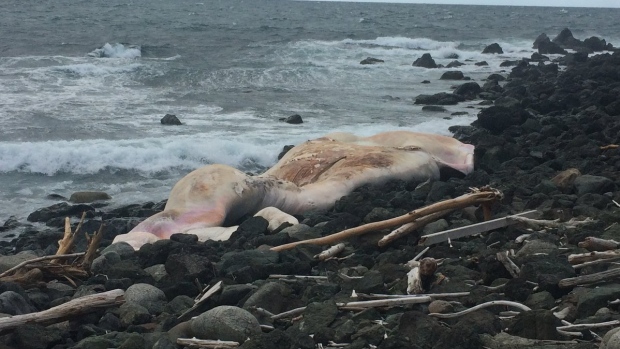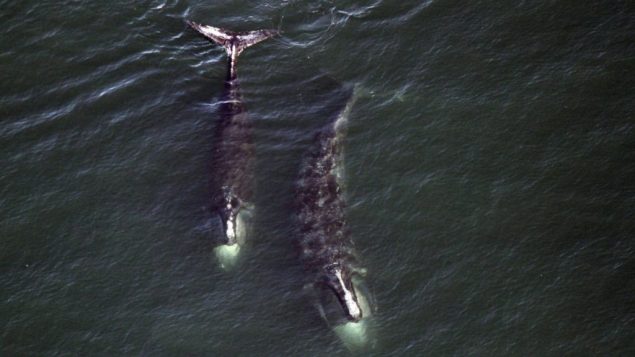Right whale deaths, 17 of them last year, and one more discovered recently in U.S. waters, were an alarming mystery for a while.
But necropsies on seven of the carcasses revealed four of them died from blunt force trauma following collisions with ships it is assumed, while three other whales were killed after becoming entangled in ropes and fishing gear.
The right whales summer in the waters of the Bay of Fundy and off the coast of the northern United States.
“No reports of new calves”
They’re also found in the Gulf of St. Lawrence and more recently have moved increasingly deeper into the gulf.

This dead North Atlantic right whale washed ashore on a beach near Lark Harbour in western Newfoundland in late July 2017. (Colleen Connors/CBC)
Now, expanded measures, tracking fishing gear and limiting the lengths of rope crab harvesters can use, are some of the steps Canada’s Minister of Fisheries and Oceans, announced on Wednesday.
“Next year’s season of potential whale migration will have a different set of rules around fishing gear, fishing practices, fishing equipment and probably the question of marine transportation as well in Canadian waters,” Dominic Leblanc said.
The right whales are endangered with only somewhere between 450 and 500 left in the world, and of those, only 100 breeding females.
The species never fully recovered following the excessive whaling practices of days gone by.
Sigrid Kuehnemund is vice president of the Oceans Program with the World Wildlife Fund of Canada.
ListenShe says they were called “right whales” because they were so easy to hunt; the “right whale”.
They travel slowly, close to the surface, and relatively close to the shore, generally within 160 kilometre distance, she explained.
Kuehnemund says they are pleased with Minister Leblanc’s announcements, and pleased with the participation of the both the fishery and the shipping industry, but they would like to see these measures more strongly enforced.

Sigrid Kuehnemunc, VP of the Oceans Program for the World Wildlife Federation of Canada. (CBC)
Kuehnemund would also like to see the government move ahead with the idea of opening the snow crab fishery earlier in the season, using icebreakers if necessary, to limit the whales exposure to ropes and traps.
Last summer, Transport Canada imposed a drop in speed limits in the western gulf, down to 10 knots an hour, for vessels over 20 metres. while travelling from the Quebec north shore to just north of Prince Edward Island.
The move was not a great success as many ships ignored the limit. There is hope there will be greater compliance with the new measure this summer.
The whales have migrated south for the winter, where they’re usually spotted off the shores of Florida and Georgia,
But Sigrid Kuehnemund says there have been very few sightings of them yet, and “no reports of new calves”.
She says “this last year was an unprecedented event with these 18 mortalities” and added to this there has been a decline in calving since 2011.
Monitoring the right whales will continue from the sea and in the air.







For reasons beyond our control, and for an undetermined period of time, our comment section is now closed. However, our social networks remain open to your contributions.